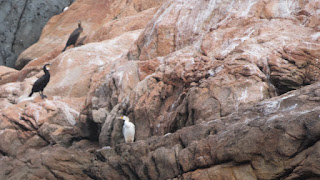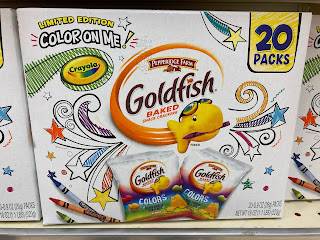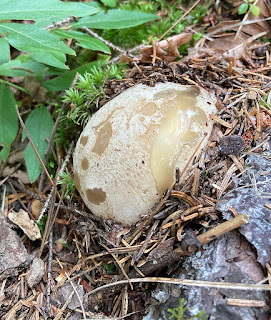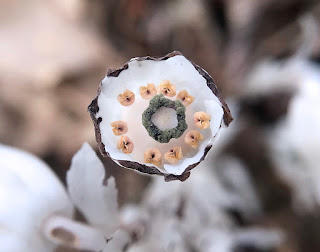Welcome to the Vinalhaven Sightings Report
September 26 2021
‘It’s ingenious for a being that has no brain to come up with that’

from Greens
photo by John Drury
Highlights – mushrooms, birds, woodland gnome, and other stuff….
Business - Poll question – is it fair to refer to the summer
of 2021 a ‘summer of mushrooms’? This is a poll conducted in your own head. If
you vote no you may not have been in the woods all summer!
Contact us –
hey – send yer photos, stories and all things nature to vinalhavensightings@gmail.com ! It’s fun to share, or at least I
am told. So here is your chance!
Tiit trick –
click on photos to magically have them grow and fill your screen! Try it with
the woodland gnome shots – you won’t be disappointed!

woodland gnome modelling orange
This does mean you can’t visit the
preserves during this time? No. In fact, it’s highly recommended that you do
visit the trails as the next few months are some of the most beautiful times to
be outside. But do yourself a favor and wear
some orange – a hat, a scarf, a
Hunter Pence SF Giants bright orange visitor jersey, whatever – so you can
be seen at a distance. Nobody wants
to shoot anyone (well, I shouldn’t speak for everyone) – or at least probably
no one wants to shoot you, and no one wants to get shot (shouldn’t speak for
everyone again) – but the bottom line is it’s an easy way to have one’s day
ruined. So slap on some orange and take in the sights! And then share them!
This northern woodland gnome is
wearing orange, are you?
birding action
photo by Rick Morgan
Bird walks –
the organized summer bird walks have wrapped up and Rick Morgan was kind enough to send in a few shots from the last
one of the season! Hats off and a standing ovation to Rick for organizing and
maintaining the walks this year (and years past!). Here are a couple of shots
Rick sent in….
great blue heron visiting beaver lodge
photo by Rick Morgan
…and just a friendly reminder that
while the organized bird walks are over, there are still plenty of birds to be
seen and more to come as winter approaches! Do yourself a favor and go look on
your own. It can be impressive what you can see when not with a group! And then
join the organized bird walks when they start up again next summer!
red-necked grebes
photo by Rick Morgan

leucistic Great Cormorant
photo by Elizabeth Andrews

another view
photo by Elizabeth Andrews
an abnormal condition of reduced pigmentation affecting various animals
(such as birds, mammals, and reptiles) that is marked by overall pale color or
patches of reduced coloring and is caused by a genetic mutation which inhibits
melanin and other pigments from being deposited in feathers, hair, or skin

Great Cormorants
photo by John Drury
Very cool and good luck to the
Cormorant! When your overall behavior, adaptations and lifestyle is based on
your naturally being dark all over, leucitism may not be the best thing for
long term survival. But hey – it looks good on that bird and who knows; maybe
it works for him/her. Either way – thanks Elizabeth for sharing!
And a Great Cormorant photo from John!

Ruby throated and Jewelweed
photo by John Drury
Hummingbird and Jewelweed – John Drury was
also kind enough to send in this photo of a Ruby-throated Hummingbird visiting a patch of Jewelweed recently. A
true treasure of the late summer/early fall, Hummingbirds are fun to track as
they visit Jewelweed flowers, their wings creating wind currents that make the jewel weed stems dance and sway hardcore.
They zip and race around, but are easy/fun to follow by watching the stems boogie
and shake. This wonderful photo captures that feeling. Love it! Great shot!
Buttered-fly on Skua – John also sent in this photo of a Black
Swallowtail butterfly that landed on his boat! Good fun out there, never
know what might just hitch a ride. Hope John was going the right way! John also
mentioned a flow of Mourning Cloaks
and Monarchs out over the open water
as well. Another great year for Monarchs (relatively). Remember when there were
few to none those couple of years, maybe 8 years back now? Anyone miss those days;
taking the monarchs for granted now? Anyway…
black swallowtail on boat
photo by John Drury
pholiotas can be quite lovely
photo by Cay Kendrick
Mushrooms –
yep, there have been tons and folks have been seeing and loving it! Cay Kendrick sent in these photos of
young Pholiotas….
Cort unfurled
photo by Cay Kendrick
…A Cortinarius sp. having its cap uncurl, with gills reaching towards
to sky undoubtedly increasing it’s (the mushroom’s) capability and probability
of having its spores captured and sent on their way in the wind. Corts are cool – more in next month’s VSR for
sure
grey coral
photo by Cay Kendrick
Cay also sent in a couple of photos
of Grey Coral, a species that is
seen yearly in woods, but often not in big numbers. 2021 has been a bomber year
for the species though, and they have been fun to spot, and once your spot one
it becomes almost a game to find others.
Look at this recent Grey Coral scene under an Eastern White Pine on the Huber Preserve. Every one of those charcoal
lumps is a Grey Coral! Fantastic!

north perry creek past prime stinkhorn
Skirted Stinkhorn – Huber and North Perry Creek. As we (the royal ‘we’) have mentioned
for years, as an observer I try to play favorites as much as possible. And when
it comes to mushrooms and spore dispersal, there is no cooler group than the
Stinkhorns (fact, not judgment).

off island stinky squid stinkhorn
And this summer, being the summer of
mushrooms, it should be no surprise that Stinkhorns have responded accordingly.
In fact, here’s a shot of a “Stinky
Squid” stinkhorn (from St George), which is the first I have seen in Maine.
This is a species that was introduced to North America in Pittsburgh (aka
Stinkhorn Capitol!) in 1915 and has been expanding its range ever since. Who
can blame it from coming to Maine…anyway
At the Huber (or ‘hubes’) I crossed
paths with this stinkhorn egg last
week right by the map that marks the ‘base’ of the lollipop loop at the shore. I
was unable to get back to it and for sure it is long gone (like a turkey
through the corn) but what has been around and sighted, and likely to be the
same species, has been Skirted
Stinkhorns.
 |
| skirted stinkhorn in its prime |
Crossed paths with a (see above) ‘past prime’ Skirted Stinkhorn at North Perry Creek when walking with Linnell
Mather last week, and found past prime examples in St George as well.
Here are a couple of videos of a Skirted Stinkhorn in action
on Clark Island in St George. Notice the grey mass the flies are eating, that’s
the secret ‘goo’ that is loaded with Stinkhorn spores.
Many get eaten and many get stuck to
legs and whatnot on the flies and are transported to new territory that way. ‘It’s ingenious for a being that has no brain
to come up with that’ – old New Jersey saying.
On the North Haven – crossed paths with this Brown Cup while monitoring on North Haven. Classic spore dispersal
in this video, that’s me mimicking wind and then it’s the cup forcibly ejecting
a cloud of spores into the air. Turn up the sound to get the full effect!
And finally – another strategy for
spore dispersal of which many are familiar with is done by puffballs (aka smoke
bombs). The Lycoperdon sp (probably Gem-studded) I’ve seen have not yet
opened for ‘puffing’ business. Instead I’ve been digging the texture of the
outer layer of spines that cover the mushrooms themselves. See what you think.

no so gross since crayons are edible I believe
One limited edition.

sunsets with friends
Some family stuff
And a final note – this VSR is at its
capacity – I have to learn when to say when -, but there is always more to
report. In theory another will be posted soon. Thank you for your patience!
And oh yeah – here’s video or two of a woodland gnome talking about tools.
Gnomes are known for bragging about
material goods. This one is particularly excited. Take a look!
See you out there!














































